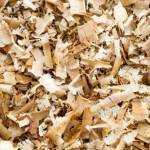Horse Stall Bedding: What Goes Into a Bag of Shavings?

Straw is a traditional material used for bedding horse stalls, but many other materials—sawdust, peat moss, shredded paper, sand, pine needles—have also been used.
Pine shavings, a product made by chopping pine logs into small, thin flakes, have become very popular in the last few decades because they are absorbent, sweet-smelling, and virtually free of mold and dust. Other favorable characteristics: stalls bedded with shavings are simple to clean, the bales are easy to handle and store, and shavings brush quickly off of a horse’s coat. Initial stall bedding requires six to 10 bales of shavings. After wet or soiled shavings are removed each time the stall is mucked out, clean shavings can be added.
Pine trees used to make shavings are usually at least 10 to 12 years old. Many are commercially grown on tree farms. The trees are cut down and small branches are trimmed off, after which the logs are trucked to a factory. There they are cut into shorter lengths, fed into a chipper, and then passed across screens to remove larger shreds. The shavings are dried in an oven, transferred to a baling room, and compressed as they are packed into paper or plastic bags. Time from raw log to finished bale is as little as 20 minutes.








